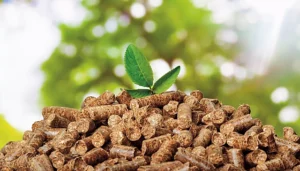Wood Pellets have gained significant popularity in recent years as an alternative energy source for heating and cooking. These small, cylindrical pieces of compressed wood offer a variety of advantages that make them an attractive option for both residential and industrial applications. In this blog post, Renenco will explore the many benefits of using wood pellets, highlighting their environmental impacts, economic efficiency, combustion properties, convenience, and diverse applications.
What are Wood Pellets?

Wood pellets are made from compressed sawdust and other wood by-products. They are typically produced through a process that involves grinding wood into a fine powder, drying it to reduce moisture content, and then compressing it into small pellet shapes under high pressure. This manufacturing process not only creates a dense fuel source but also helps eliminate waste from the lumber industry. The end product is a highly efficient fuel that can be used in various applications, making it a versatile choice for many.
The appeal of wood pellets lies in their ability to provide a cleaner, more efficient alternative to traditional fossil fuels. As awareness of climate change and the need for sustainable practices grows, wood pellets have emerged as a viable solution for those looking to reduce their carbon footprint while still enjoying the comforts of modern living.
Environmental Benefits
The environmental benefits of using wood pellets cannot be overstated. They play a crucial role in reducing our reliance on fossil fuels and promoting sustainability.
Reduced greenhouse gas emissions

One of the most significant advantages of wood pellets is their potential to reduce greenhouse gas emissions. When burned, wood pellets release carbon dioxide; however, this carbon is part of a natural cycle. Trees absorb carbon dioxide as they grow, and when they are harvested for fuel, the carbon is released back into the atmosphere. This process is different from burning fossil fuels, which releases carbon that has been trapped underground for millions of years, significantly increasing atmospheric carbon levels.
Moreover, studies have shown that using wood pellets instead of traditional fossil fuels can lead to a substantial decrease in overall greenhouse gas emissions. In many cases, switching to wood pellets can result in a reduction of up to 80% in emissions compared to natural gas or coal. This shift is essential for mitigating climate change and working towards a more sustainable future.
Reuse of wood waste
Another critical aspect of wood pellets is their ability to utilize wood waste materials that would otherwise contribute to landfill issues. By transforming sawdust, wood shavings, and other by-products from the lumber industry into pellets, we can effectively minimize waste and promote a circular economy.
This reuse of wood waste not only helps reduce the amount of debris littering our environment but also supports responsible forestry practices. Sustainable sourcing of wood pellets ensures that forests are managed correctly, allowing for healthy trees to continue growing while excess materials are repurposed. Emphasizing waste reduction and resourcefulness is vital for protecting our planet’s ecosystems.
Sustainable renewable energy
Wood pellets are classified as a renewable energy source, as they are made from biomass – organic material derived from plants and animals. Unlike fossil fuels, which take millions of years to form, wood can be replenished relatively quickly through responsible forest management practices. As long as forests are cared for and not overharvested, the supply of wood pellets can be sustained indefinitely.
Furthermore, many pellet producers actively promote sustainable forestry certifications, ensuring that the wood used for production comes from responsibly managed sources. This commitment to sustainability not only benefits the environment but also supports local economies, as many wood pellet manufacturers rely on regional suppliers for their raw materials.
Economic Efficiency

In addition to their environmental benefits, wood pellets offer economic advantages that make them an appealing choice for consumers and businesses alike.
Cost compared to traditional fuels
When comparing wood pellets to traditional fuels like oil, natural gas, or electric heating, consumers often find that wood pellets can provide considerable cost savings. While prices can fluctuate based on factors such as location and market demand, wood pellets tend to maintain competitive pricing, particularly in regions where they are widely available.
Additionally, the price of wood pellets is typically less volatile than that of fossil fuels, which can be subject to dramatic fluctuations based on geopolitical tensions and supply disruptions. This stability allows homeowners and businesses to budget for heating costs with greater confidence, knowing that they are less likely to experience sudden spikes in energy expenses.
Long-term cost savings
Although the initial investment in a wood pellet stove or boiler may be higher than that of traditional heating systems, the long-term savings associated with wood pellets can be significant. Given their high energy density and efficiency, wood pellets can produce more heat per unit compared to conventional fuels, leading to reduced heating bills over time.
Moreover, by utilizing locally sourced wood pellets, consumers can further decrease transportation costs and support their communities. Investing in wood pellet technology can ultimately lead to lower energy costs and a more sustainable financial model for homeowners and businesses in the long run.
Stable seasonal prices
Another appealing aspect of using wood pellets for heating is the relative stability of their prices throughout the year. Unlike heating oil or natural gas, which often experience seasonal price fluctuations due to supply and demand changes during colder months, wood pellets tend to maintain consistent pricing.
This predictability can help consumers manage their budgets more effectively, especially in areas where heating costs are a significant portion of household expenditures. With certainty in pricing, families can invest in wood pellets confidently, knowing that their energy expenses will remain stable and manageable throughout the winter season.
High Combustion Efficiency
One of the key performance attributes of wood pellets is their combustion efficiency, which surpasses that of traditional firewood.
Compared to traditional firewood
Wood pellets are designed for optimal burning, providing a clean and efficient heat source. Traditional firewood can vary significantly in moisture content, species, and size, leading to inconsistent combustion and energy output. In contrast, wood pellets are manufactured to standard specifications, ensuring uniformity in size, density, and moisture content.
The higher combustion efficiency of wood pellets means that less fuel is needed to produce the same amount of heat. This efficiency translates to fewer resources consumed and less pollution generated, making wood pellets an environmentally friendly choice for heating.
Stable heat generation
Another benefit of using wood pellets is their ability to provide stable and consistent heat output. Unlike traditional firewood, which can produce unpredictable heat levels depending on the type of wood and how well it was seasoned, wood pellets deliver a steady burn.
Pellet stoves and boilers are specifically engineered to regulate combustion, resulting in reliable and continuous heat. This stability is especially valuable in cold climates, where maintaining a comfortable temperature indoors is essential for personal comfort and health.
Low ash and residue
In addition to their high energy output and stability, wood pellets produce substantially less ash and other residues compared to traditional firewood. Because of their uniform composition and low moisture content, wood pellets leave behind a minimal amount of ash when burned.
This characteristic makes cleaning and maintenance easier, as users will spend less time emptying ash bins and dealing with messes. Furthermore, the low residual waste produced contributes to cleaner burning, meaning that less particulate matter is released into the atmosphere.
Convenient to Use and Maintain

The convenience of using wood pellets extends beyond their combustion properties. Their easy handling and storage make them a practical choice for many households.
Easy to transport and store
Wood pellets come in compact bags, making them easy to transport and store. Unlike bulky firewood logs that require significant space and effort to stack, wood pellets can be simply kept in a corner of a garage or shed without taking up much room.
This compact nature also facilitates transportation, as multiple bags can be loaded onto a vehicle without the hassle of securing large logs. For urban dwellers or those with limited outdoor space, this convenience is a significant advantage.
Automatic fueling
Many modern wood pellet stoves and boilers feature automatic feeding systems that allow for hands-free operation. These systems utilize augers to feed pellets from a hopper into the combustion chamber, ensuring a constant and uninterrupted heat supply.
This automation means that users do not need to manually add fuel every few hours, as is necessary with traditional firewood. The ease of operation provided by these advancements in technology increases the appeal of wood pellet heating systems, particularly for busy households.
Long storage time
Wood pellets have a longer shelf life than traditional firewood, as they can be stored for extended periods without losing their efficacy. Properly sealed bags of wood pellets can remain usable for several years without degradation in quality.
This longevity makes wood pellets an excellent choice for individuals who want to stock up on fuel during warmer months when prices may be lower. Users can buy in bulk and rest assured that their fuel supply will remain effective even after prolonged storage.
Diverse Applications

The versatility of wood pellets is another compelling reason to consider their use across various domains, including heating, cooking, and industrial applications.
Space Heating
Wood pellets are primarily recognized for their effectiveness in space heating, providing warmth and comfort to residential buildings. Pellet stoves and boilers can efficiently heat single rooms or entire homes, serving as an alternative to traditional gas or electric heating systems.
In addition to being a renewable energy source, pellet heating systems can be integrated into existing heating setups. Many homeowners opt to install pellet stoves alongside their conventional systems, allowing them to use the most cost-effective fuel source depending on fluctuating energy prices.
Cooking and Water Boiling
Beyond heating, wood pellets are increasingly being utilized for cooking purposes. Wood pellet grills offer a unique flavor-enhancing experience that can elevate barbecuing and smoking outcomes. These grills employ precise temperature control, making it easy for users to achieve their desired level of doneness while infusing meals with a rich, smoky taste.
Similarly, wood pellets can be used for boiling water and cooking in various settings, including camping and outdoor events. Their compact size and lightweight nature make them suitable for portable cooking solutions, offering versatility for outdoor enthusiasts.
Industrial Applications
In addition to residential uses, wood pellets find applications in various industrial sectors. Companies focusing on energy generation often incorporate wood pellets into their biomass power plants, supplementing conventional fuel sources and reducing overall emissions.
Industries seeking sustainable alternatives to fossil fuels can leverage wood pellets as a renewable energy source to power operations, reduce their carbon footprint, and comply with environmental regulations. This shift toward greener energy sources is not just beneficial for the planet, but it can also enhance corporate social responsibility efforts and improve company image.
Conclusion

In summary, wood pellets present a myriad of benefits that extend beyond simple heating solutions. From their positive environmental impact to economic efficiency, high combustion effectiveness, and convenience, as well as their wide range of applications, wood pellets have emerged as a promising alternative energy source.
By choosing wood pellets, individuals and businesses can significantly reduce their carbon footprint while enjoying the advantages of efficient, renewable energy. The transition to wood pellets not only supports sustainability but also aligns with global efforts to combat climate change and promote cleaner living. Whether for home heating, cooking, or industrial applications, the versatility and benefits of wood pellets make them an excellent choice for conscious consumers. Follow Fanpage Renenco to update the latest tips about wood pellets.




